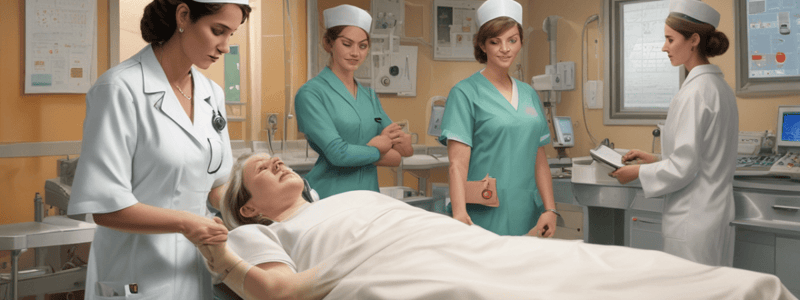Podcast
Questions and Answers
What is a key consideration for everyone in the operating room regarding proper positioning?
What is a key consideration for everyone in the operating room regarding proper positioning?
- Ensuring the patient is comfortable
- Monitoring blood pressure changes
- Maximizing access to the surgical site
- Removing jewelry and hair ornaments (correct)
Why should pressure on the eyes be avoided during patient positioning in the operating room?
Why should pressure on the eyes be avoided during patient positioning in the operating room?
- To reduce risk of eye injuries
- To prevent nerve injuries (correct)
- To maintain patient comfort
- To avoid impairing vision
What physiological change occurs in an awake patient when lying supine?
What physiological change occurs in an awake patient when lying supine?
- Increase in stroke volume (correct)
- Decrease in venous return
- Decrease in cardiac output
- Decrease in arterial blood pressure
In the operating room setting, what is the main goal of proper positioning in relation to the surgeon's needs?
In the operating room setting, what is the main goal of proper positioning in relation to the surgeon's needs?
Why should attempts to bend a limb a certain way be avoided after anesthesia if it does not bend that way before anesthesia?
Why should attempts to bend a limb a certain way be avoided after anesthesia if it does not bend that way before anesthesia?
What should be avoided when a patient is positioned for surgery to prevent harm?
What should be avoided when a patient is positioned for surgery to prevent harm?
What is the recommended limit for abduction when trying to prevent ulnar neuropathies?
What is the recommended limit for abduction when trying to prevent ulnar neuropathies?
Which complication is strongly related to the surgical procedure time during Lithotomy surgeries?
Which complication is strongly related to the surgical procedure time during Lithotomy surgeries?
Where should the arms be positioned during Lateral Decubitus surgeries?
Where should the arms be positioned during Lateral Decubitus surgeries?
Which position should the patient's head be kept in during Lateral Head/neck considerations?
Which position should the patient's head be kept in during Lateral Head/neck considerations?
What is an essential precaution mentioned to avoid complications during Lateral Head/neck positioning?
What is an essential precaution mentioned to avoid complications during Lateral Head/neck positioning?
Why is it recommended to use an 'axillary roll' during certain surgeries?
Why is it recommended to use an 'axillary roll' during certain surgeries?
What is a patient risk factor for perioperative vision loss?
What is a patient risk factor for perioperative vision loss?
Which factor is recommended to be avoided to prevent central retinal artery occlusion (CRAO) during long spine surgeries?
Which factor is recommended to be avoided to prevent central retinal artery occlusion (CRAO) during long spine surgeries?
What positioning recommendation is given to high-risk patients during long spine surgeries?
What positioning recommendation is given to high-risk patients during long spine surgeries?
Which of the following is NOT a perioperative factor associated with perioperative vision loss?
Which of the following is NOT a perioperative factor associated with perioperative vision loss?
What is recommended to avoid in positioning high-risk patients during long spine surgeries?
What is recommended to avoid in positioning high-risk patients during long spine surgeries?
"Positioningrelated recommendations" in the text emphasize avoiding which aspect during surgeries?
"Positioningrelated recommendations" in the text emphasize avoiding which aspect during surgeries?
What approximate distance is there between the brain and the site of the BP cuff on the arm in the seated position?
What approximate distance is there between the brain and the site of the BP cuff on the arm in the seated position?
What is the typical difference between the brain MAP and the measured mean brachial artery pressure?
What is the typical difference between the brain MAP and the measured mean brachial artery pressure?
What can happen if the beach chair position is combined with deliberate hypotension?
What can happen if the beach chair position is combined with deliberate hypotension?
In case of venous air embolism with a small amount of air, what happens to the air?
In case of venous air embolism with a small amount of air, what happens to the air?
What are the potential outcomes of a large amount of air entering in venous air embolism?
What are the potential outcomes of a large amount of air entering in venous air embolism?
Which condition is NOT associated with venous air embolism?
Which condition is NOT associated with venous air embolism?
What is the most likely cause of vision loss in Case Study 1 upon awakening?
What is the most likely cause of vision loss in Case Study 1 upon awakening?
Based on the ASA Practice Advisory, what is recommended for 'high risk' patients undergoing complex spine surgery?
Based on the ASA Practice Advisory, what is recommended for 'high risk' patients undergoing complex spine surgery?
What was the initial reason attributed to the bilateral loss of vision noted in Case Study 2?
What was the initial reason attributed to the bilateral loss of vision noted in Case Study 2?
Which surgery was performed in Case Study 2 that led to bilateral loss of vision?
Which surgery was performed in Case Study 2 that led to bilateral loss of vision?
What diagnostic tool was used to evaluate motor neuropathies according to the text?
What diagnostic tool was used to evaluate motor neuropathies according to the text?
What is recommended regarding head positioning for 'high risk' patients undergoing complex spine surgery?
What is recommended regarding head positioning for 'high risk' patients undergoing complex spine surgery?
The approximate distance between the brain and the site of the BP cuff on the arm in the seated position is fixed at 20 cm.
The approximate distance between the brain and the site of the BP cuff on the arm in the seated position is fixed at 20 cm.
The brain Mean Arterial Pressure (MAP) will always be equal to the measured mean brachial artery pressure.
The brain Mean Arterial Pressure (MAP) will always be equal to the measured mean brachial artery pressure.
Combining the beach chair position with deliberate hypotension can improve cerebral perfusion.
Combining the beach chair position with deliberate hypotension can improve cerebral perfusion.
Venous Air Embolism can lead to arrhythmia, desaturation, pulmonary hypertension, circulatory compromise, and cardiac arrest.
Venous Air Embolism can lead to arrhythmia, desaturation, pulmonary hypertension, circulatory compromise, and cardiac arrest.
When a small amount of air enters the circulation, it is absorbed by the alveoli and is easily detected.
When a small amount of air enters the circulation, it is absorbed by the alveoli and is easily detected.
A large amount of air entering the circulation can lead to an increase in EtCO2.
A large amount of air entering the circulation can lead to an increase in EtCO2.
Nerve injury during surgery is a significant source of professional liability.
Nerve injury during surgery is a significant source of professional liability.
Stretch, ischemia, and compression are three common mechanisms for nerve injury during surgery.
Stretch, ischemia, and compression are three common mechanisms for nerve injury during surgery.
Anesthetized patients can show early warning symptoms of pain if they experience nerve injury during surgery.
Anesthetized patients can show early warning symptoms of pain if they experience nerve injury during surgery.
The ASA Closed Claims do not contain any information related to nerve injury during surgeries.
The ASA Closed Claims do not contain any information related to nerve injury during surgeries.
Study Notes
Perioperative Visual Loss (POVL)
- POVL is a serious complication that can occur during surgery
- High-risk patients include those undergoing complex spine surgery, those with hypertension, diabetes, atherosclerosis, morbid obesity, and tobacco use
- Intraoperative factors that contribute to POVL include prolonged hypotension, long duration of surgery, prone position, large blood loss, large crystalloid use, anemia, and hemodilution
- External compression of the abdomen or chest should be avoided
Positioning
- The entire OR team shares responsibility for proper patient positioning
- Jewelry and hair ornaments should be removed, and pad surfaces, lumbar support, and natural joint position should be maintained
- The head should remain midline, and pressure on the eyes should be avoided
Supine Position
- This is the most common position for surgery
- Hemodynamic reserve is best maintained, and the entire body is close to the level of the heart
- Complications of the supine position include pressure alopecia, prolonged immobilization of the head, and peripheral nerve injury
Lithotomy Position
- This position is used for surgeries involving the perineum, medial thighs, genitalia, and rectum
- Care should be taken to prevent dislocation of the hips
- Complications of the lithotomy position include compartment syndrome, which can result in ischemia, edema, and rhabdomyolysis
Lateral Decubitus Position
- This position is used for surgeries involving the thorax, retroperitoneal structures, or hip
- Anterior and posterior support should be provided, and arms should be positioned in front of the patient
- The dependent arm should be on an arm board, and the non-dependent arm should be supported
Prone Position
- This position is used for surgeries involving the posterior cervical spine and posterior fossa
- The patient's head should be in a neutral position, and the eyes should be securely taped
- The lower portion of each bolster or roll must be under the iliac crest
Sitting Position
- This position is used for surgeries involving the posterior cervical spine and posterior fossa
- Advantages include surgical exposure, decreased blood in the field, and reduced perioperative blood loss
- Disadvantages include venous air embolism and hemodynamic effects
Nerve Injury
- Nerve injury is a serious perioperative complication and a significant source of professional liability
- Three mechanisms of injury include stretch, ischemia, and compression
- The anesthetized patient cannot show early warning symptoms of pain, nor can reposition themselves spontaneously
Studying That Suits You
Use AI to generate personalized quizzes and flashcards to suit your learning preferences.




